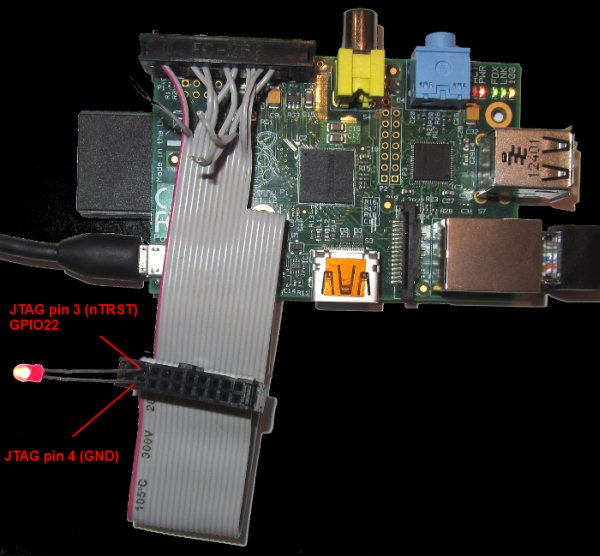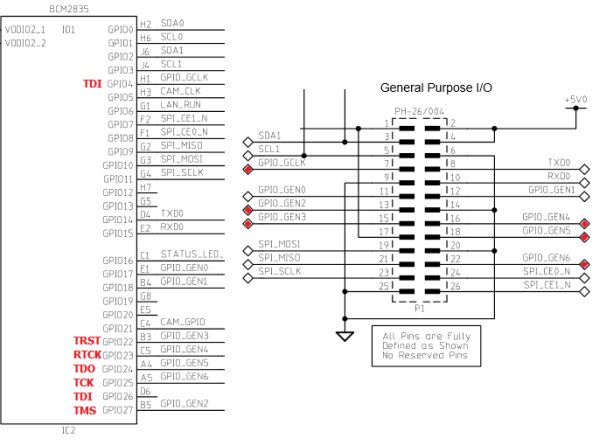This tutorial shows how to prepare your Raspberry PI board for debugging with JTAG. Using JTAG will allow debugging the Linux kernel using hardware like Segger J-Link. As Raspberry PI board does not have a connector with a normal JTAG layout, preparing the board for JTAG debugging involves finding the correct pins and wiring them in the correct order. Follow the steps below for a complete walkthrough:
- Determine the revision of your Raspberry PI board. Connect to it using SSH and run the following command:
- Use the revision table to look up the board revision. In this tutorial we will use Model B v2.0 (revision 0xe).
- In order to find which pins on the board are JTAG pins we need to first find the GPIO numbers that correspond to them. JTAG requires 4 pins: TDI, TDO, TMS and TCK plus TRST and RTCK pins. Get the peripheral datasheet for BCM2835, the microcontroller used by the Raspberry PI board. Search for “_TCK” to find the GPIO number table:

-
JTAG pin “ALT4” mode “ALT5” mode TDI GPIO26 GPIO4 TDO GPIO24 GPIO5 TMS GPIO27 GPIO12 TCK GPIO25 GPIO13 RTCK GPIO23 GPIO6 TRST GPIO22 N/A - Download Raspberry PI schematics PDF for the board revision you found out in step 2. Each JTAG pin (except TRST) can be routed to one of 2 GPIO pins. Use the schematics to find GPIO pins that are connected to the GPIO connector:
- We will now need to wire the selected pins from the P1 connector to a 20-pin JTAG connector. Use the JTAG-20 pinout to map the P1 pins to the JTAG-20 pins:
JTAG-20 pin JTAG signal GPIO pin ALT mode P1 pin 1 VREF N/A N/A 1 3 nTRST GPIO22 ALT4 15 4 GND N/A N/A 9 5 TDI GPIO4 ALT5 7 7 TMS GPIO27 ALT4 13 9 TCK GPIO25 ALT4 22 11 RTCK GPIO23 ALT4 16 13 TDO GPIO24 ALT4 18 - Now we can make an adapter cable that will connect the pins from the 26-pin P1 connector on Raspberry PI to the 20-pin JTAG connector. This can be done by carefully opening and detaching the 26-pin connector from a 26-pin cable and attaching the wires from the 14-pin cable to it ordered according to the table above:
Each wire can be carefully pushed into the correct position using a pincette
Double-triple check your wiring. Wrong wiring/cable orientation can permanently damage your Raspberry PI, your JTAG programmer and even your PC connected to it! Test the correctness of each pin. E.g. we can test JTAG pin 3 (nTRST = GPIO22) by connecting a LED between pins 3 and 4 (4 is GND) and running the following commands in your Raspberry PI terminal over SSH:
echo 22 > export
cd gpio22
echo out > direction
echo 1 > value
 This will turn on the LED until we run ‘echo 0 > value':
This will turn on the LED until we run ‘echo 0 > value':
- Now that we have verified that the GPIO pins are connected to correct JTAG pins we need to switch them from the GPIO mode to JTAG mode. The table above summarized the alternative function numbers that we need to select for each pin. This is done by accessing the GPFSELx registers of the BCM2835 chip. The easiest way to access them from a user-mode Linux program is by using the /dev/mem device (note that the 0x7E20xxxx addresses mentioned in the BCM2835 reference are the physical addresses. the corresponding virtual addresses are 0x2020xxxx). To do this, upload, the JtagEnabler.cpp file to your Raspberry PI, compile and run it:
g++ -o JtagEnabler JtagEnabler.cpp
sudo ./JtagEnablerBelow is the code responsible for setting the alternative functions for all affected pins:
GpioFunctionSelector selector;
selector.SetGPIOFunction(22, GPIO_ALT_FUNCTION_4);
selector.SetGPIOFunction(4, GPIO_ALT_FUNCTION_5);
selector.SetGPIOFunction(27, GPIO_ALT_FUNCTION_4);
selector.SetGPIOFunction(25, GPIO_ALT_FUNCTION_4);
selector.SetGPIOFunction(23, GPIO_ALT_FUNCTION_4);
selector.SetGPIOFunction(24, GPIO_ALT_FUNCTION_4); - Now we are ready to start debugging. In this tutorial we will use a Segger J-Link programmer with the OpenOCD tool, however you can use any other supported programmer instead. Download our OpenOCD package and the USBDriverTool. Connect the J-Link programmer, launch USBDriverTool, select the J-Link device and install the WinUSB drivers for it:
For more detail: Preparing Raspberry PI for JTAG Debugging

